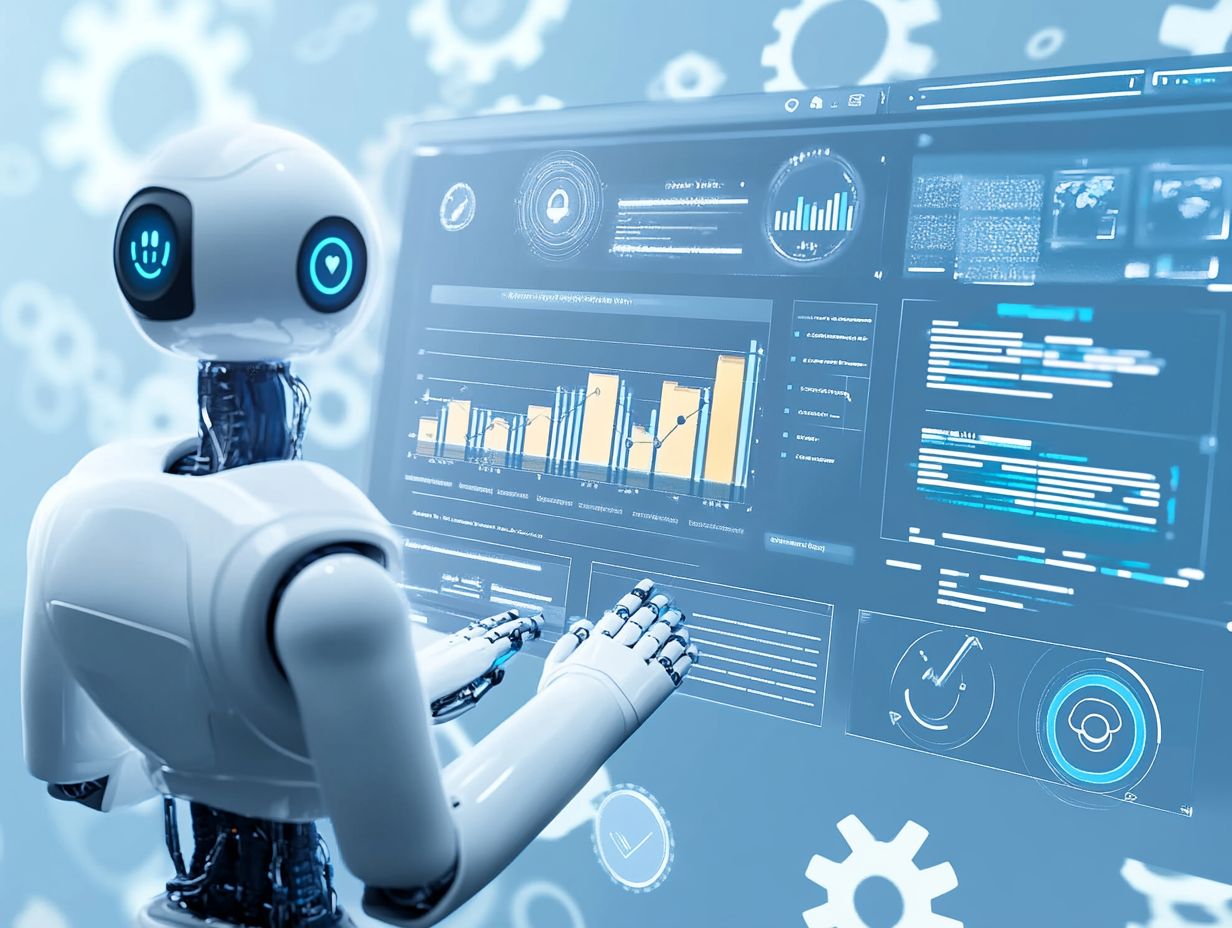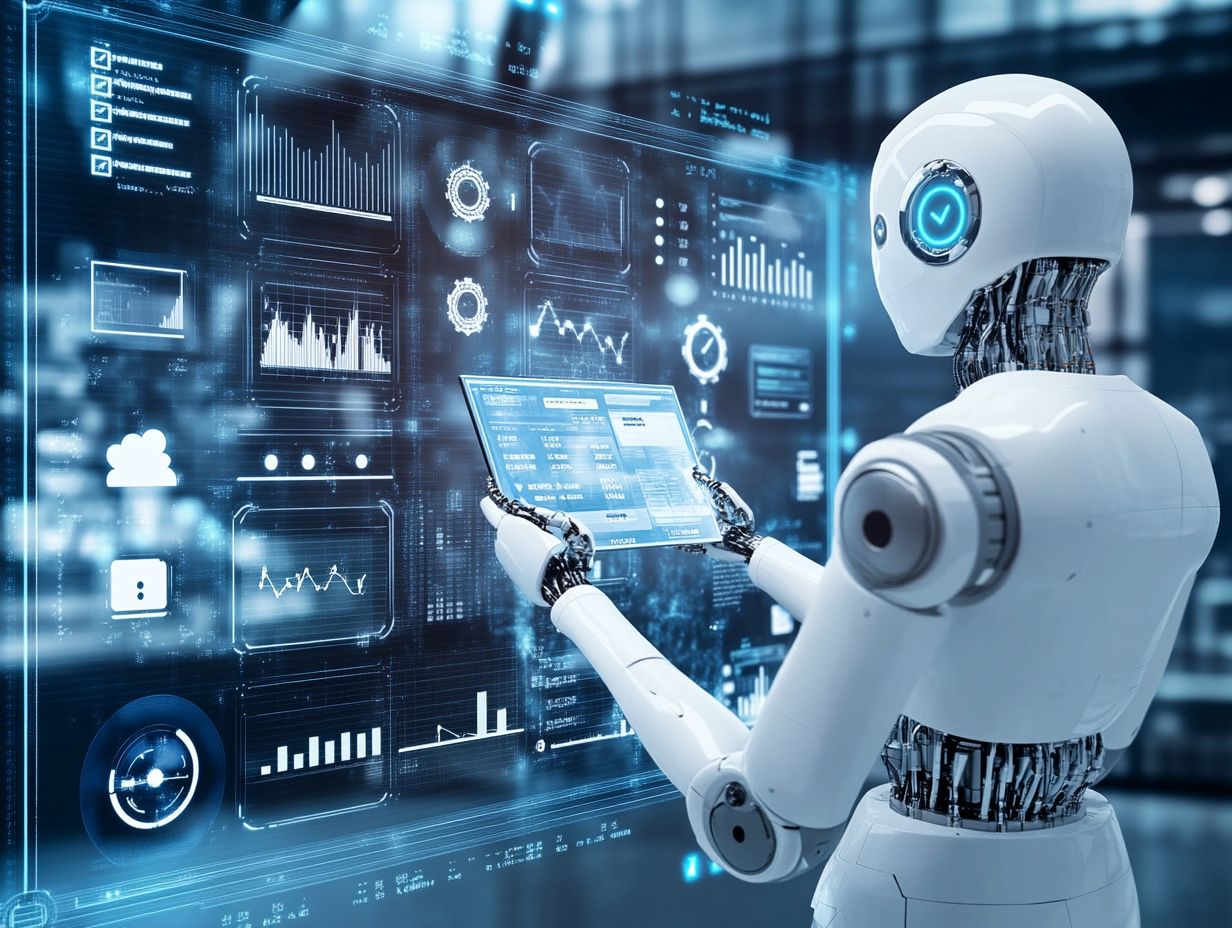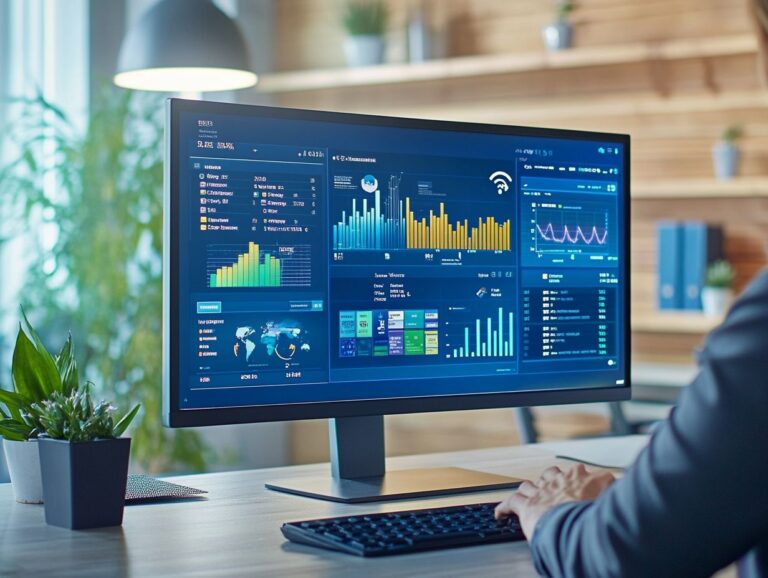AI-Powered Techniques for Enhancing Conversion Rate Optimization (CRO)
In today’s fiercely competitive digital landscape, Conversion Rate Optimization (CRO) has emerged as an essential strategy for businesses like yours that seek to maximize their online potential.
While traditional CRO techniques certainly hold value, they often come with their own set of challenges, including limited data, resource intensity, and a lack of personalization.
Fortunately, innovative solutions are paving the way for a transformative approach to CRO. This article delves into the importance of enhancing your CRO efforts, the array of AI techniques for content creation at your disposal, and how to implement these powerful strategies effectively.
Prepare to uncover how these fresh approaches can revolutionize your conversion rates and propel your business growth to new heights.
Contents
- What is Conversion Rate Optimization (CRO)?
- Why is CRO Important for Businesses?
- What are the Challenges in Traditional CRO Techniques?
- How Can AI Help with CRO?
- What are the Different AI Techniques Used in CRO?
- What are the Benefits of Using AI in CRO?
- How to Implement AI-Powered CRO Techniques?
- Frequently Asked Questions
- What is AI-Powered CRO and how does it work?
- Why is AI technology beneficial for CRO?
- What are some common AI-Powered techniques used for CRO?
- Can AI-Powered CRO be used for all types of websites?
- How does AI-Powered CRO impact the user experience?
- Is AI-Powered CRO a one-time process or an ongoing effort?
What is Conversion Rate Optimization (CRO)?

Conversion Rate Optimization (CRO) is your strategic pathway to elevating the percentage of website visitors who engage in desired actions, be it completing a purchase, subscribing to a newsletter, or filling out a contact form.
By employing a range of techniques like A/B testing, personalization, and data analytics, you can significantly enhance user experience and drive revenue growth.
This meticulous process requires a deep understanding of user behavior, optimizing landing pages, and analyzing conversion metrics, all of which work together to create effective conversion paths that seamlessly guide visitors through the sales funnel.
Why is CRO Important for Businesses?
Recognizing the significance of Conversion Rate Optimization (CRO) is essential for any business aiming to elevate its online presence and boost revenue.
With effective CRO strategies in place, you can transform a greater number of visitors into loyal customers, thereby enhancing your conversion rates and fueling revenue growth.
By optimizing user engagement at every stage of the customer journey, you can refine your lead generation efforts and secure a more impressive return on investment for your marketing endeavors.
What are the Challenges in Traditional CRO Techniques?
Traditional Conversion Rate Optimization (CRO) techniques frequently face challenges that can hinder their ability to enhance user experience and boost conversion rates. One major obstacle is the scarcity of data and insights necessary for making informed optimization decisions, often leading to a lack of personalization that resonates with user behavior.
Furthermore, these conventional CRO methods can prove to be time-consuming and resource-intensive, demanding substantial investments in both strategy development and execution.
1. Limited Data and Insights
Limited data and insights present a formidable challenge in Conversion Rate Optimization (CRO), as they prevent you from making informed, data-driven decisions based on real user behavior. Without comprehensive data analytics at your disposal, you may find it difficult to grasp visitor engagement and pinpoint the key conversion metrics that could significantly enhance your optimization strategies.
This lack of information can lead to ineffective marketing campaigns and misguided improvements to user experiences, ultimately resulting in missed opportunities for growth and revenue generation. It s all too easy to rely on tactics rooted in assumptions rather than solid evidence, which can waste both your time and resources.
To combat this, integrating robust data-gathering tools such as heatmaps, A/B testing, and customer feedback platforms can be a game changer. By leveraging these solutions, you can gain invaluable insights into user interactions, allowing you to tailor your strategies effectively and seize potential conversion pathways.
2. Time-consuming and Resource-intensive
The time-consuming and resource-intensive nature of traditional CRO methods can easily deter you from pursuing effective optimization strategies. Implementing A/B testing and other conversion optimization tools often demands significant investments in both time and human resources, which can put a strain on smaller organizations like yours.
Managing multiple tests simultaneously can lead to what feels like analysis paralysis, leaving your team overwhelmed and uncertain about the next steps. Budget constraints only add to these challenges, as many companies struggle to allocate funds for extensive user research or advanced analytics platforms.
Given these hurdles, it s worthwhile to explore alternative approaches that harness automation and user-friendly software solutions. Tools equipped with machine learning capabilities can simplify data analysis, while streamlined testing frameworks allow for rapid iterations without ballooning costs.
By adopting these innovative resources, you can not only overcome traditional limitations but also significantly enhance your optimization efforts, driving better results with less friction.
3. Inability to Personalize User Experience
One of the significant challenges you might face with traditional CRO techniques is the struggle to effectively personalize the user experience, which can have a profound effect on your conversion rates. Without tailored experiences that resonate with each unique user, guiding potential customers along their distinct journeys can become quite difficult.
In a world where consumer expectations are in constant flux, relying on a one-size-fits-all strategy can quickly become outdated and ineffective. Today s users expect a more engaging experience, and when they encounter generic content that doesn t speak to their specific needs or interests, their engagement drops off sharply.
This lack of personalization can lead to users abandoning their shopping carts or clicking away entirely, ultimately harming your conversion rates. To combat this issue, it s essential to prioritize behavioral targeting and implement customized content strategies that adapt to user preferences and behaviors.
By taking these steps, you can create a more relevant experience that not only captures attention but also fosters lasting loyalty.
How Can AI Help with CRO?
Artificial Intelligence (AI) is poised to transform Conversion Rate Optimization (CRO) in remarkable ways, providing you with sophisticated techniques for analyzing user behavior and predictive analytics.
With automated insights and customized personalization strategies at your disposal, you can elevate user experiences and substantially boost conversion rates. By leveraging AI-driven tools, you ll be able to fine-tune your marketing efforts to align seamlessly with the needs of your target audience, ensuring a more effective approach that truly resonates with them.
1. AI-Powered User Behavior Analysis

AI-powered user behavior analysis equips you with sophisticated tools to gather and interpret data analytics, leading to enhanced website performance and personalized user experiences. By harnessing behavioral insights, you gain a deeper understanding of visitor interactions and preferences, enabling more effective conversion strategies.
This capability is invaluable, as it allows you to uncover hidden patterns in user behavior that traditional analysis methods might overlook. For example, utilizing tools like Google Analytics with AI enhancements can reveal peak usage times, allowing you to tailor content delivery to fit your audience’s habits perfectly.
Moreover, methodologies such as predictive analytics enable you to forecast future interactions based on past behaviors, optimizing your marketing campaigns for greater effectiveness. By integrating AI technologies, you create a more responsive and dynamically web experience, ultimately boosting user engagement and driving conversions.
2. Personalization and Customization of User Experience
AI give the power tos you to elevate user experiences through advanced personalization and customization, utilizing dynamic content delivery and behavioral targeting. By segmenting your audience based on their interactions and preferences, you can craft tailored experiences that resonate with each individual visitor, ultimately enhancing your conversion rates.
This approach not only boosts user satisfaction but also fosters loyalty, making consumers feel truly understood and valued. For example, e-commerce giants like Amazon utilize AI algorithms to analyze buying habits and browsing behaviors, delivering product recommendations that align seamlessly with your interests.
Similarly, Spotify leverages AI to curate personalized playlists and music suggestions, captivating you with content that feels uniquely yours. These successful personalized marketing campaigns demonstrate how AI tools can redefine traditional methodologies, creating bespoke interactions that profoundly influence purchasing decisions and drive greater engagement across various platforms.
3. Predictive Analytics for Targeted Campaigns
Predictive analytics powered by AI equips you with the ability to forecast user behavior and craft targeted campaigns that drive higher conversion rates. By looking into historical data and trends, you can make informed decisions that optimize your marketing strategies for exceptional results.
By harnessing sophisticated algorithms, you can uncover patterns and segment audiences based on their preferences and behaviors. This targeted approach not only elevates customer engagement but also ensures that your marketing resources are allocated with precision.
To implement predictive modeling effectively, you need to collect relevant data, choose the right tools, and continuously refine your algorithms based on real-time feedback. Collaboration between your marketing and data analytics teams is essential, as it fosters deeper insights that can shape your future campaigns.
The outcome? You not only boost conversion rates but also build lasting relationships with your clientele, paving the way for long-term success.
What are the Different AI Techniques Used in CRO?
Numerous AI techniques play a pivotal role in elevating your Conversion Rate Optimization (CRO) strategies. Techniques such as machine learning, natural language processing, and neural networks are not just buzzwords; they are the advanced tools that harness data analytics to generate insights.
By utilizing these methodologies, you can significantly enhance the effectiveness of your CRO initiatives, give the power toing your business to drive improved engagement and conversion rates.
1. Machine Learning
Machine learning stands as a powerful AI technique that allows you to delve deep into user behavior and effectively predict outcomes in the realm of Conversion Rate Optimization (CRO). By harnessing algorithms that learn from data, you can craft predictive models that refine your CRO strategies.
This technology excels at processing extensive datasets, granting you a nuanced understanding of customer interactions and preferences. For example, e-commerce platforms can utilize machine learning to evaluate various elements, such as website layout or call-to-action buttons, pinpointing which variations significantly boost user engagement.
Consider the case of a leading online retailer that implemented machine learning to personalize product recommendations based on browsing history, resulting in an impressive 30% increase in sales conversions. Such advanced analysis not only enhances your current strategies but also aids in forecasting future trends, give the power toing you to maintain a competitive edge in the market.
2. Natural Language Processing (NLP)
Natural Language Processing (NLP) is an AI technique that significantly enhances your user experience by analyzing feedback and optimizing content through linguistic insights. This powerful capability enables you to tailor your messaging to resonate more deeply with your audience, ultimately resulting in improved conversion rates.
Through advanced sentiment analysis and user intent recognition, NLP offers profound insights into the motivations that drive consumer behavior. For example, an e-commerce platform like yours could harness NLP to sift through customer reviews and pinpoint common pain points, allowing for adjustments in product descriptions and user interfaces that genuinely address user concerns.
You can observe successful implementations of NLP in conversion rate optimization (CRO) at firms like Amazon, where dynamic content adjustments based on customer queries have led to remarkable increases in engagement and sales. With chatbots powered by NLP, you can elevate real-time customer interactions, leading to enhanced satisfaction and a greater likelihood of purchases.
These applications not only refine your content but also ensure that your marketing strategies are meticulously aligned with the actual needs of your users.
3. Neural Networks
Neural networks embody a cutting-edge AI technique that can elevate your Conversion Rate Optimization (CRO) efforts to new heights by adeptly modeling the intricate patterns in user behavior through advanced data analytics. These sophisticated algorithms have the power to unveil insights that refine your optimization strategies, ultimately enhancing your conversion metrics.
By sifting through vast amounts of data, neural networks can pinpoint subtle trends and correlations that traditional methods may easily overlook. For example, imagine an e-commerce platform harnessing these advanced models to analyze user interactions across multiple touchpoints. This enables you to fine-tune landing pages or personalize recommendations tailored to individual preferences, enhancing the overall user experience.
Companies like Netflix and Amazon have successfully woven neural networks into their user experience strategies, leading to heightened customer engagement and substantial boosts in conversion rates. Ultimately, the capacity of neural networks to process and interpret complex datasets give the power tos you to make informed, data-driven decisions, propelling your CRO initiatives forward with confidence.
What are the Benefits of Using AI in CRO?

The advantages of incorporating AI into Conversion Rate Optimization (CRO) are substantial and varied, offering you improved efficiency and a deeper understanding of user behavior.
By harnessing AI-driven insights, you can elevate your conversion rates and refine your strategies with greater precision, ultimately leading to a more impressive return on investment (ROI).
1. Improved Efficiency and Accuracy
Incorporating AI into your Conversion Rate Optimization (CRO) strategies brings substantial benefits, particularly in improving efficiency and accuracy. By automating processes and enhancing your decision-making capabilities, AI optimization tools allow you to streamline workflows and achieve superior results with significantly less manual effort.
Consider how machine learning algorithms can analyze user behavior patterns and segment audiences far more effectively than traditional methods ever could. Tools like Optimizely and VWO harness AI to run A/B tests, accurately predicting which variations will yield higher local SEO conversion rates based on historical data trends.
Additionally, AI-driven chatbots engage customers in real time, offering personalized recommendations that can drive increased sales. Companies like Amazon and Netflix have mastered this integration, analyzing vast amounts of consumer data to refine the user experience and substantially boost conversion rates.
As the digital marketing landscape continues to evolve, embracing AI’s role in enhancing your CRO strategies is not just beneficial; it’s essential for staying ahead.
2. Better Understanding of User Behavior
AI give the power tos you to gain a deeper understanding of user behavior, offering invaluable insights that can shape your optimization strategies and elevate the user experience. This enhanced understanding allows you to target and personalize your approach more effectively, ultimately leading to improved conversion rates.
With the aid of advanced analytics and sophisticated machine learning algorithms, you can identify patterns in customer interactions and preferences. By scrutinizing data from various touchpoints such as website visits, social media engagement, and purchase history AI unveils intricate user trends that reveal not just what customers are purchasing, but also the underlying motivations that drive their decisions.
You can harness these insights to customize your marketing strategies, refine your product offerings, and significantly boost customer engagement. Predictive modeling powered by AI enables you to foresee future behaviors, allowing you to make proactive adjustments to your services that resonate with users, thereby reinforcing their loyalty and driving revenue growth.
3. Increased Conversion Rates and Revenue
One of the most compelling advantages of incorporating AI into your conversion rate optimization (CRO) strategy is the remarkable potential for increased conversion rates and revenue. By harnessing advanced optimization techniques that leverage AI insights, you can effectively attract and retain customers, ultimately enhancing your bottom line.
Consider the success stories of industry giants like Amazon and Netflix, who have masterfully utilized AI to craft highly personalized experiences for their users. Amazon leverages machine learning algorithms to analyze browsing and purchasing patterns, enabling tailored product recommendations that significantly boost conversion rates. Similarly, Netflix employs AI to suggest shows and movies based on individual viewing habits, keeping users engaged and fostering subscriptions.
These examples demonstrate that adopting AI-driven CRO strategies not only elevates user experiences but also directly contributes to a healthier revenue stream. This makes it an essential tool for any modern business aiming to thrive in today’s competitive landscape and leverage AI-powered techniques for creating content that converts.
How to Implement AI-Powered CRO Techniques?
Implementing AI-powered Conversion Rate Optimization (CRO) techniques requires a strategic mindset, focusing on data collection, choosing the right optimization tools, and engaging in continuous testing and optimization processes.
By adhering to a structured methodology, you can effectively leverage the capabilities of AI to elevate your CRO initiatives and achieve remarkable results.
1. Collect and Analyze Data
The first step in implementing AI-powered conversion rate optimization (CRO) techniques is to collect and analyze data that reveals insights into user behavior. By gathering comprehensive data from diverse sources, you can identify patterns and trends that inform your optimization strategies.
This process often involves utilizing specialized tools and methodologies that enhance your data acquisition. For instance, heat mapping software can help visualize user interactions, while A/B testing frameworks enable controlled experimentation to fine-tune your approach.
By leveraging machine learning algorithms, you can automate the analysis of complex datasets, uncovering actionable insights that drive your CRO efforts. Integrating customer feedback and behavioral analytics gives you a holistic view of user engagement, allowing you to tailor your strategies accordingly.
Ultimately, effective data collection and analysis give the power to you to refine your marketing tactics while elevating the overall customer experience, resulting in improved conversion outcomes.
2. Choose the Right AI Tools
Choosing the right AI tools is essential for successfully implementing AI-powered Conversion Rate Optimization (CRO) strategies. By selecting optimization tools that align with your business goals, you can enhance data analytics, improve the user experience, and drive better conversion outcomes.
When evaluating potential AI solutions, it s crucial to assess their capabilities in areas such as personalization, predictive analytics, and real-time data processing. For instance, tools like Optimizely provide robust A/B testing features that allow you to gain deeper insights into user behavior, while Adobe Target excels at delivering personalized experiences tailored to your audience.
Incorporating solutions like Google Analytics can also offer valuable insights into traffic sources and user interactions, further supporting your strategic decisions. Ultimately, the effectiveness of these AI tools depends on their ability to streamline your operations and optimize customer touchpoints, resulting in increased engagement and higher conversion rates.
3. Test and Optimize

The final step in implementing AI-powered CRO techniques is for you to continuously test and optimize your strategies based on the performance data you collect. Utilizing methods like A/B testing and performance tracking will give the power to you to refine your conversion metrics and enhance overall results.
These methodologies are crucial for understanding user behavior and preferences, enabling you to make targeted adjustments that significantly boost user engagement. By systematically analyzing the outcomes of different variations, you can pinpoint which elements resonate best with your audience, driving higher conversion rates in the process.
Integrating heat maps and user journey analysis will provide you with deeper insights into visitor interactions. To ensure sustained improvements, it’s essential for you to follow best practices such as:
- Setting clear objectives for each test
- Maintaining a consistent testing schedule
- Leveraging advanced analytics tools for comprehensive performance tracking
Regularly revisiting and revising your optimization strategies not only bolsters your conversion metrics but also keeps you aligned with evolving customer needs.
Frequently Asked Questions
What is AI-Powered CRO and how does it work?
AI-Powered CRO (Conversion Rate Optimization) is a process of using artificial intelligence and machine learning techniques to improve the conversion rate of a website or digital platform. AI technology analyzes user behavior and makes data-driven recommendations for optimizing the website’s design and content, ultimately leading to an increase in conversions.
Why is AI technology beneficial for CRO?
AI technology has the ability to process and analyze large amounts of data at a faster and more accurate rate than humans. This allows for more efficient and effective optimization strategies to be implemented, leading to a higher conversion rate. Additionally, AI can continuously learn and adapt, making it a powerful tool for ongoing CRO efforts.
What are some common AI-Powered techniques used for CRO?
Some common AI techniques used for CRO include machine learning algorithms, predictive analytics, natural language processing, and image recognition. These techniques allow AI to analyze user behavior, understand their preferences and intent, and make personalized recommendations for improving the conversion rate.
Can AI-Powered CRO be used for all types of websites?
Yes, AI-Powered CRO can be used for all types of websites, including e-commerce, lead generation, and content-based websites. The technology is adaptable and can be customized to fit the specific needs and goals of each website, making it a valuable tool for all types of businesses.
How does AI-Powered CRO impact the user experience?
AI-Powered CRO can greatly improve the user experience by providing personalized and relevant content to each user. By analyzing user behavior and preferences, AI can make recommendations for website design and content changes that will lead to a better user experience and ultimately increase the conversion rate.
Is AI-Powered CRO a one-time process or an ongoing effort?
AI-Powered CRO is an ongoing effort. As user behavior and preferences change over time, AI technology continues to learn and adapt to ensure that the website is continuously optimized for maximum conversions. Ongoing monitoring and updates are necessary to maintain a high conversion rate.





